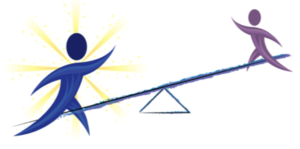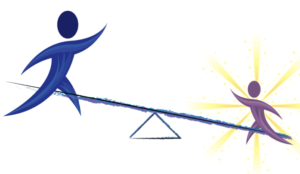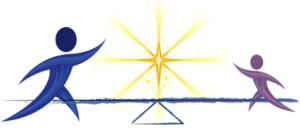The personalization of learning requires the relationship of students and teachers to shift to partnership and shared responsibility. Educational change in Vermont has also opened the door to unprecedented opportunities for young people to be central to change, rather than passive recipients. However, there are few roadmaps for shifting our mental models and practices to partnership.
This blog explores one dynamic that has repeatedly challenged forming authentic, equitable youth-adult partnerships in UP teams over the past 12 years. I share it with the hope that naming and exploring this potential pitfall will expedite the journey for others on the road to youth-adult partnership. I first explain the “Teeter-Totter Effect” and then offer ways we have developed to circumvent this challenge.
The Teeter-Totter Effect Overview
The journey from an adult-dominated decision making model to a youth-adult partnership model requires a recalibration of norms, including mental models, power, communication, collaboration, decision making, and shared responsibility. As with any change in beliefs and practices, the recalibrating process can be anything but simple and linear! Below is one pattern that UP has observed repeatedly in a youth-adult team or schools’ journey to partnership, best explained through the teeter-totter metaphor.
In our dominant cultural norm, adults are grounded with the power and responsibility to shape most aspects of educational decisions, essentially “doing education toand foryouth.” Youth are “along for the ride” in a largely passive role. Being suspended in air can feel delightfully unburdened or frustratingly out of control. The response of youth ranges from acceptance and comfort (e.g., playing the game of school), to anger and withdrawal (e.g., dropping out). Adults are firmly grounded in a comfortable and known role, often unaware that they are missing an invaluable perspective in their process of decision-making.
When the teeter-totter is in this position, the wisdom, knowledge, passion, commitment, and ownership of one of the major stakeholder groups in education –students– will be missing in the process of learning and school change.
Youth-dominated
When a culture begins to shift to youth-adult partnership, it seeks to rectify the long-standing imbalance of power and omission of youth in decision-making. Adults step back to make space for youth voice and power, but can over-correct by largely removing their own voice and input. They now are passively “along for the ride,” believing that their role is to defer all responsibility and decision making to youth. They fear that any attempt to share their knowledge or opinions will demean the new partnership. Youth often feel joy in this new role of responsibility and sense of power, sometimes offset by uncertainty or confusion due to lack of supports and structure. They can believe that the correction of the power imbalance requires this youth-only shift – it is their turn! Adults appreciate witnessing the youth leadership and learning capacity, but feel helpless and frustrated when they have knowledge or insight into a situation where their input could help inform the learning or outcome.
When the teeter-totter swings to this position, the wisdom, knowledge, passion, commitment, and ownership of one of the major stakeholder groups in education –educators– will be missing in the process of learning and school change.
Youth-adult partnership
Youth-adult partnership in its authentic, equitable form allows both youth and adults to be firmly grounded in shared power and responsibility. Both generations readily share their wisdom, knowledge, passion, and commitment. Students and teachers know that they are invaluable partners with a relationship rooted in respect, trust, and equity. All feel the joy and weight of shared responsibility and continually build their capacity as change agents in their own lives and in shaping their school community. Both learning and school change efforts are orchestrated “with” youth in contrast to being done “to and for them.’ Decision-making is flexible, with youth sometimes in the lead and at other times adults. A trusting and mutually respectful relationship makes this both comfortable and empowering.
Realizing the full potential of both stakeholder groups results in an unprecedented capacity to co-create an engaging and inclusive learning environment, seeding lifelong civic capacity.
How can I expedite my school’s shift to youth-adult partnership?
UP has been working for years to help youth-adult teams hone their partnerships. We recognize the “teeter-totter effect,” where one generation or the other may end up with an outsized share of power and leave the other hanging. We know it takes time to get to “four feet on the ground,” the balanced sharing of responsibility and power that makes youth-adult partnership most effective. For those engaged in this challenging paradigm shift, here are a few of the lessons we’ve learned and some accompanying tools.
- Help both youth and adults understand the WHY of the change to youth-adult partnership, creating a shared vision for this destination. Shifting mental models of roles and responsibilities is key to implementing personalized and proficiency-based learning. Yet we have observed that many students, and also educators, feel that this is simply a new method being imposed on them. They do not completely understand the necessity of shifting relationship norms to realize the full potential of these practices.Additionally, when people not familiar with education jargon hear “youth voice and choice” or “personalized learning” or “student-centered learning”, the youth dominated model is often what they assume is the suggested change – and react negatively in response. The “What’s the Deal with Proficiency-based Learning” video is a helpful tool to explore the “why” of change, and seed a discussion about the changes necessary. Linking the reasons for personalized learning to brain-based research has also proven to be an effective way to address concerns.
- Help people understand the destination and the incremental steps to that end.Provide a “Roadmap” to introduce the broad concepts of the youth-adult partnership journey, naming the core variables that must shift along the way. Create dialogue about the change in roles and responsibilities, openly exploring the pros and cons, challenges and opportunities. This shared understanding and language for the process of change can serve as an ongoing touchstone to expedite the paradigm shift. UP has created the Youth-Adult Partnership Roadmap rubric which may be helpful in this regard. Additionally, the “Taking the Pulse of Partnership” rubric is a tool to help teams monitor the meeting and task management process.
- Create community commitments or norms that reflect partnership…and then embed these norms into the fabric of the team’s relationships. The easiest way to expedite the teeter-totter recalibration process is to establish a safe environment to co-create norms that support partnership, beginning with trust, respect and equity of voice. Once these norms have been agreed upon by both youth and adults, they must be referenced regularly. There must also be an allowance for inadvertently reverting back to old patterns, and an agreed-upon means of “gentle reminders” to put the group back on track. As previously noted, this is anything but a linear or simple process! Mistakes are often a catalyst for the most poignant moments of growth, as new norms take root. UP frequently weaves in Margaret Wheatley’s poem “Turning to One Another” (see end of blog) as a component of deciding upon these new inclusive and empowering principles and practices.
Four feet on the ground:
The promise of balancing the teeter-totter
- Students understand the importance of their role in learning, sparking ownership and engagement.
- Teachers can focus more on facilitating learning and less on behavior management; time previously consumed by a power dynamic (eg. “make me learn”) is replaced by learning itself.
- Academic performance increases setting off the cascade of positive ripples that come with academic success
- There is renewed hope when both adults and youth know that they matter – to each other, and to the learning and school change process itself.
- There is equity in access to engaging learning, where each and every young person believes in their capacity and agency in the world.
Imbued with purpose and hope, youth-adult partnership brings out our “best selves.’ All parties are fully empowered to work in community toward a shared goal. In the words of Margaret Wheatley:
“There is no power greater than a community discovering what it cares about.”
This op-ed was originally published for Education Reimagined on January 2019.
Helen Beattie is the founder and Executive Director of UP for Learning (Unleashing the Power of Partnership for Learning). Her seemingly eclectic professional and academic life course has woven itself into the creation of UP for Learning. It reflects a life-long passion for elevating the voices of those who feel disempowered and voiceless, either in the health or education realms.

